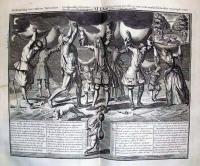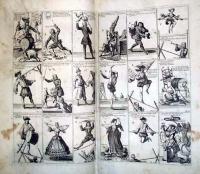Het groote tafereel der dwaasheid, vertoonende de opkomst, voortgang en ondergang der actie, bubbel en windnegotie, in Vrankryk, Engeland, en de Nederlanden, gepleegt in den jaare MDCCXX. Zynde een verzameling van alle de conditien en projecten van de opgeregte compagnien van assurantie, navigatie, commercie, &c. in Nederland, zo wel die in gebruik zyn gebragt, als die door de h. staten van eenige provintien zyn verworpen: als meede konst-plaaten, comedien en gedigten, door verscheide liefhebbers uytgegeeven tot beschimpinge deezer verfoeijelyke en bedrieglyke handel, waar door in dit jaar, verscheide familien en persoonen van hooge en lage stand zyn geruineerd, en in haar middelen verdorven, en de opregte negotie gestremt, zo in Vrankryk, Engeland als Nederland…
(The Great Mirror of Folly, showing the rise, progress, and downfall of the bubble in stocks and windy speculation, especially in France, England and the Netherlands in the year 1720, being a collection of all the terms and proposals of the incorporated companies for insurance, navigation, trade, &c. in the Netherlands, both those of which have gone into actual operation and those which have been rejected by the legislatures in various provinces. With prints, comedies, and poems, published by various amateurs, scoffing at this terrible and deceitful trade, by which various families and persons of high and low condition were ruined in this year, and possessions lost, and honest trade stopped, not only in France and England but in the Netherlands…).
[Amsterdam?] 1720. 131 p. in various pagings: 73 plates (part fold., incl. ports., maps, plans) 40 cm. Various pieces in prose and verse on the financial transactions of John Law and others, brought together under a general title-page. Graphic Arts Collection (GAX) Oversize 2006-0014F
Here are only 3 of the 73 engraved plates from The Great Mirror of Folly, offering satirical scenes in the rise, progress, and downfall of stocks in France, England and the Netherlands during 1720. The volume is also informally known as The Great Bubble Book after the speculator’s bubbles that burst, causing the first great stock market crash in September of that year. This is an unusual book for many reasons. It was issued without an author or publisher or even city of origin identified. Each individual volume appears to be a unique compilation of prints and texts, holding between 49 and 74 images from up to 56 different engravers.
To see more, Harvard University’s South Sea Bubble site, has a complete index, including digital images of their edition: http://www.library.hbs.edu/hc/ssb/recreationandarts/tafereel.html


